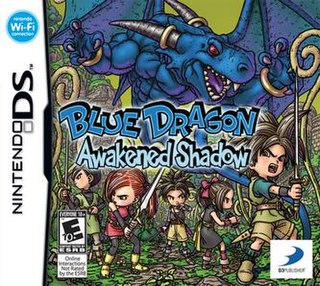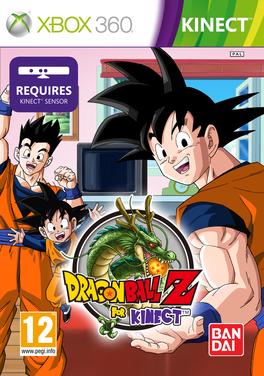
Dragon Ball GT: Final Bout, known in Japan and Europe as Dragon Ball: Final Bout, is a fighting game for the PlayStation. The game was developed by TOSE and released by Bandai in Japan, Europe and North America in 1997, making it the first North American release for a Dragon Ball video game.

Dragon Ball Z: The Legacy of Goku is a series of video games for the Game Boy Advance, based on the anime series Dragon Ball Z and part of the Dragon Ball video game series. All three games are action role-playing games. The first game, Dragon Ball Z: The Legacy of Goku, was developed by Webfoot Technologies and released in 2002. The game was followed by two sequels: Dragon Ball Z: The Legacy of Goku II, released in 2003, and Dragon Ball Z: Buu's Fury, released in 2004. In 2016, Webfoot Technologies claimed to be starting development of another sequel.

Dragon Ball Z: Harukanaru Densetsu, known as Dragon Ball Z: Harukanaru Goku Densetsu in Japan and Dragon Ball Z: Goku Densetsu in Europe, is a card based role-playing video game for the Nintendo DS. The game takes place from the beginning of the Saiyan Saga to the end of the Cell Saga. Players choose from one of the four main character, Goku, Gohan, Piccolo, and Vegeta. Other characters also appear, but only as either enemies or support cards.

Dragon Ball Z: Budokai Tenkaichi, released in Japan as Dragon Ball Z: Sparking!, is a series of fighting games developed by Spike based on the Dragon Ball franchise by Akira Toriyama. The series was published by Namco Bandai Games in Japan and Europe, and by Atari in North America and Australia until 2008. Since the third game, Bandai Namco has handled Dragon Ball game publishing in all regions, effectively ending Atari's involvement.

Dragon Ball: Origins known as in Japan, is a video game for the Nintendo DS based on the Dragon Ball franchise created by Akira Toriyama. The game was developed by Game Republic and published by Atari and Namco Bandai under the Bandai label. It was released on September 18, 2008 in Japan, November 4, 2008 in North America, December 5, 2008 in Europe, and December 11, 2008 in Korea. The game was released in Australia on December 4, 2008, but was later recalled as its PG rating did not reflect the "racy" content found in the game and was subsequently given a higher rating.

Dragon Ball Z: Infinite World is a fighting video game for the PlayStation 2 based on the Dragon Ball franchise. The game was developed by Dimps, and published in North America by Atari, and in Europe and Japan by Namco Bandai Games under the Bandai label. It was released in North America on November 4, 2008, in Japan on December 4, and in Europe the following day.

Blue Dragon: Awakened Shadow is an action role-playing video game developed by Mistwalker and tri-Crescendo for the Nintendo DS. It was released by Namco Bandai in Japan in October 2009 and Europe in September 2010 and by D3 Publisher in North America in May 2010.

Dragon Ball: Raging Blast is a video game based on the manga and anime franchise Dragon Ball. It was developed by Spike and published by Namco Bandai for the PlayStation 3 and Xbox 360 game consoles in North America; internationally it was published under the Bandai label. It was released in Japan, North America, Europe, and Australia during the second week of November 2009. In Europe, a limited edition pack of the game was also released that included bonus collector material.

Dragon Ball: Revenge of King Piccolo, released in Japan as Dragon Ball: World's Greatest Adventure, is a video game based on the Dragon Ball franchise. It was developed by Media.Vision and published by Namco Bandai under the Bandai label. It was released in Japan on July 23, 2009, and in other territories in October of that same year.

Dragon Ball: Origins 2, known as Dragon Ball DS 2: Charge! Red Ribbon Army in Japan, is a video game for the Nintendo DS based on the Dragon Ball franchise and the sequel to 2008's Dragon Ball: Origins. The game was developed by Game Republic and published by Namco Bandai throughout North America and everywhere else under the Bandai label. Released in 2010.

Dragon Ball: Raging Blast 2 is a video game based on the manga and anime franchise Dragon Ball and is a follow-up to the 2009 video game Dragon Ball: Raging Blast. It was developed by Spike and published by Namco Bandai under the Bandai label for the PlayStation 3 and Xbox 360 gaming consoles in the beginning of November 2010.

Dragon Ball Z Side Story: Plan to Eradicate the Saiyans is a 1993 card battle role-playing game developed by Tose and published by Bandai for the Family Computer game console. Based on the Dragon Ball franchise, the player's movement and battle choices are dictated by randomly generated playing cards.

Dragon Ball Kai: Ultimate Butōden is a fighting video game for the Nintendo DS based on the Dragon Ball franchise. It was released only in Japan on February 3, 2011.

Dragon Ball Z: Ultimate Tenkaichi is a game based on the manga and anime franchise Dragon Ball Z. It was developed by Spike and published by Namco Bandai Games under the Bandai label in late October 2011 for the PlayStation 3 and Xbox 360.

Dragon Ball Z: Battle of Z is an action role-playing fighting game based on the Dragon Ball franchise. It was developed by Artdink and published by Bandai Namco Games. The game features elements from the 2013 Dragon Ball Z film, Battle of Gods, including the first appearance in a Dragon Ball video game of Goku's Super Saiyan God form, Beerus, and Whis.

Dragon Ball Z: For Kinect is a video game based on the anime series Dragon Ball Z for the Xbox 360's Kinect. Published by Namco Bandai Games under the Bandai label and developed by Spike Chunsoft, the game was released in October 2012. It is one of the few Dragon Ball games that never saw a release in Japan, although it still features a Japanese speech track available for international players.

Dragon Ball Xenoverse is an action role-playing fighting game based on the Dragon Ball franchise developed by Dimps and published by Bandai Namco Games. It was released in February 2015 for PlayStation 3, PlayStation 4, Xbox 360, Xbox One, and Microsoft Windows.

Dragon Ball Xenoverse 2 is an action role-playing fighting game developed by Dimps and published by Bandai Namco Entertainment based on the Dragon Ball franchise, and is the sequel to the 2015 game Dragon Ball Xenoverse. It was released on October 25, 2016, for PlayStation 4 and Xbox One, and on October 27 for Windows. In Japan, Dragon Ball Xenoverse 2 was initially only available on PlayStation 4. The game was released for the Nintendo Switch in Japan on September 7, 2017, and later released worldwide on September 22, 2017. The game was released on Stadia on December 17, 2019.

Dragon Ball Z: Kakarot is an action role-playing game developed by CyberConnect2 and published by Bandai Namco Entertainment, based on the Dragon Ball franchise. It was released for PlayStation 4, Xbox One and Windows in January 2020, Nintendo Switch in September 2021, Stadia in October 2021, PlayStation 5 in January 2023, and Xbox Series X/S in February 2023. The game follows the main protagonist Goku and the Z-Fighters throughout the events of the Dragon Ball Z anime, including anime-original storylines and moments.


















